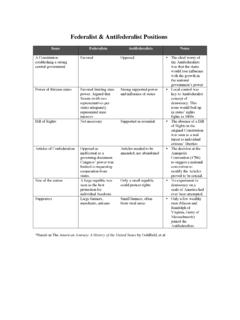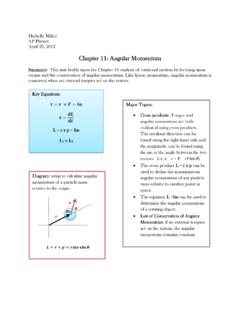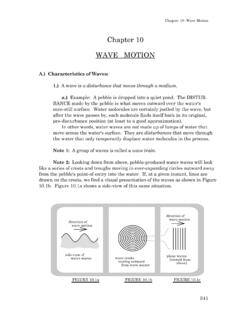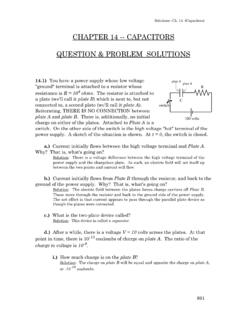Transcription of CHAPTER 16 -- MAGNETIC FIELDS QUESTION & PROBLEM …
1 Solutions--Ch. 16 ( MAGNETIC FIELDS )917 CHAPTER 16 -- MAGNETIC FIELDSQUESTION & PROBLEM ) What is the symbol for a MAGNETIC field? What are its units? Also, whatare MAGNETIC FIELDS , really?Solution: As a vector, the symbol for a MAGNETIC field is B. Its units are teslas. Inreality, MAGNETIC forces are relativistic effects produced by charge in relative phenomenon was observed before Einstein's relativity existed. As aconsequence, the observers attributed to the phenomenon a new, special vector called that vector field a MAGNETIC ) What are MAGNETIC forces? That is, how do MAGNETIC forces act; what dothey act on; what, in general, do they do?Solution: Within the context of what has become known as the classical theory ofmagnetism, MAGNETIC FIELDS create forces on charges whose motion cuts acrossmagnetic field lines.
2 That is, MAGNETIC FIELDS are associated with MAGNETIC forces, butthey aren't modified force FIELDS the way electric FIELDS are. MAGNETIC forces acceleratemoving charge centripetally according to the relationship F = qvxB, where q is thesize of the charge moving with velocity v through the MAGNETIC field ) Give two ways you can tell if a MAGNETIC field exists in a region of : The easiest way to detect a MAGNETIC field is with a compass. A moreobscure way is to shoot a charged particle through the region. If its path arcs,assuming the change of direction can't be attributed to gravity, you probably have amagnetic field in the ) The direction of an electric field line is defined as the direction a positivetest charge would accelerate if put in the field at the point of interest.
3 How aremagnetic field lines defined?Solution: The direction of a MAGNETIC field line at a particular point is defined as thedirection a compass would point if put at that ) What does the magnitude of a MAGNETIC field tell you?Solution: The magnitude of a MAGNETIC field tells you the amount of MAGNETIC flux perunit area associated with a particular point. MAGNETIC flux has the units of webers, sothe units for the MAGNETIC field are technically webers per square ) What kind of forces do MAGNETIC FIELDS produce?Solution: A MAGNETIC force will not change the magnitude of a charged particle'svelocity. What it will change is the direction of a moving, charged particle's is, MAGNETIC forces act ) You put a stationary positive charge in a MAGNETIC field whose direction isupwards toward the top of the page.
4 Ignoring gravity:a.) What will the charge do when released?Solution: A stationary charge in a MAGNETIC field will do absolutely FIELDS are modified force FIELDS . Release a stationary charge in anelectric field and the field will change the charge's velocity--the charge willaccelerate along the line of the field. MAGNETIC FIELDS are not modified force FIELDS affect charges only if the charge is in motion, and only then if thereis a component of the motion that cuts across MAGNETIC field lines. In short, acharge released from rest in a MAGNETIC field will just sit ) How would the answer to Part 7a change if the charge had beennegative?Solution: Generally, negative charges do exactly the opposite of positive this particular case, given the fact that a positive charge would do nothing inthe MAGNETIC field, one would expect that a negative charge would also ) In what direction would the charge have to move to feel a magneticallyproduced force into the page?
5 If allowed to move freely, would the charge continueto feel that force into the page?Solution: The direction of the MAGNETIC field is toward the top of the page. Todetermine the direction of a MAGNETIC force on a moving charge, you need toevaluate vxB ( , you need to use the right hand rule). The direction of thatcross product will give you the direction of that force. You know the direction ofthat force--it's into the page--and you know the direction of B--it's toward the topof the page. In other words, the QUESTION becomes, in what direction would youhave to extend your hand ( , in what direction is v?--this is what you are lookingfor) so that when you curl your fingers toward the top of the page ( , in thedirection of B), your thumb extends into the page ( , in the direction of themagnetic force)?
6 The velocity direction that satisfies this QUESTION points to theleft. Note that, as always with a cross product, the direction of the cross product( , the direction of F) is perpendicular to the plane defined by the two vectors( , v and B). As to whether that force would be felt continuously in thatdirection, the answer is no! As the charge begins to move into the page,motivated by the original MAGNETIC force, the direction of the charge's velocityvector would change, the direction of the cross product vxB would change, and thedirection of the MAGNETIC force F would change. In short, the charge would circleinto the page motivated by a MAGNETIC force that was always perpendicular tothe charge's motion. So, the force wouldn't always be directed into the 16 ( MAGNETIC FIELDS )919 FIGURE IIB-field (into page)AFEDCGd.
7 How would the answer to Part 7c change if the charge had been negative?Solution: Negative charges do the exact opposite of positive charges. In thiscase, a negative charge would have to move to the right to feel a force into thepage due to a MAGNETIC field directed upward toward the top of the ) The positive charge is given an initial velocity of 2 m/s directed upwardtoward the top of the page. How will its velocity change with time?Solution: A moving charge has to cross MAGNETIC field lines before a magneticforce is felt. As this charge is traveling along the MAGNETIC field lines, there is noforce on the charge and its motion will continue ) Six particles with the same mass move through a MAGNETIC field directedinto the page (Figure II).
8 A.) Identify the positively charged,negatively charged, and electricallyneutral masses. (Hint: How would youexpect a positively charged particle tomove when traveling through a B-fielddirected into the page?)Solution: The cross product in F =qvxB allows us to determine theDIRECTION of the force on apositive charge moving in a the right hand rule (v x B)on a charge moving in the figure,we will see positive charge bend in the direction of that force while negativecharge bends opposite that direction. Noting that non-charged particles do notdeviate in the B-field at all, we can write:--Charges A and G must be positive;--Charges D and E must be negative;--Charges C and F must be ) Assuming all the particles have the same charge-magnitude, which oneis moving the fastest?
9 (Hint: For a fixed charge, how is charge velocity and radiusof motion related? Think!)Solution: Assuming v and B are perpendicular to one another ( , the sine ofthe angle between the two vectors is one), the magnitude of the MAGNETIC forcewill be F = qvB. Noting that all MAGNETIC forces are centripetal in nature, we canuse to write: Fcent:qvB = mac = m(v2/R)or920 FIGURE 2B-field out of pageqvelectrical potential Voelectrical potential zeroFc v = other words, for a fixed q, B, and m, the velocity is proportional to the radiusof the motion. The largest radius in the picture appears to be that associatedwith charge G (charge D is a close second), therefore charge G is moving ) Assuming all the particles have the same velocity, which one has thegreatest charge?
10 (Same hint as above, but reversed.)Solution: Re-manipulating the previous equation above, we get: q = a given m, v, and B, the charge is indirectly proportional to the radius ofmotion. In other words, holding all else constant, a large charge will have a smallradius (this makes sense--the bigger the charge, the bigger the MAGNETIC force onthe particle and, hence, the tighter the circle). As such, the greatest charge shouldbe charge ) A positive charge q = 4x10-9 coulombs and mass m = 5x10-16 kilogramsaccelerates from rest through a potential difference of Vo = 2000 volts. Onceaccelerated, it enters a known MAGNETIC field whose magnitude is B = ) On the sketch in FigureIV, draw in an approximaterepresentation of the charge' : The fact thatthe charge is positivecoupled with the crossproduct F = qvxB allowsus to draw the path ofthe particle as it movesthrough the B-field (seeFigure 2 to the right).




